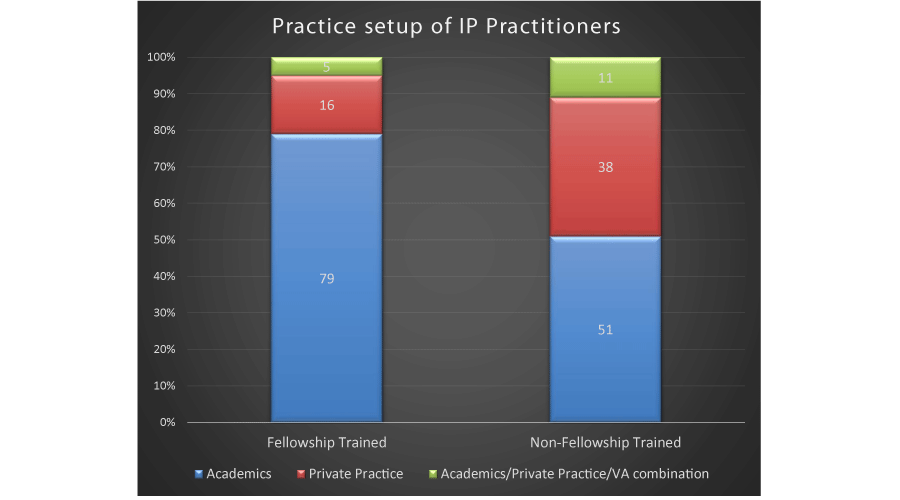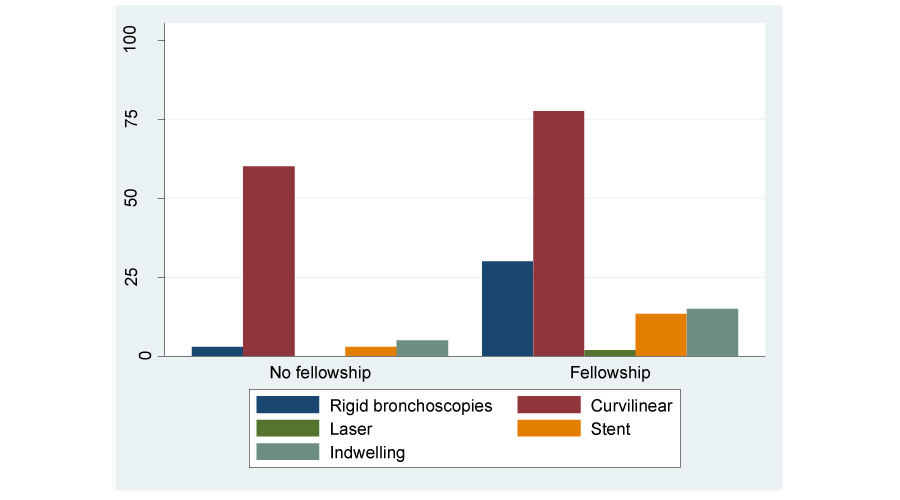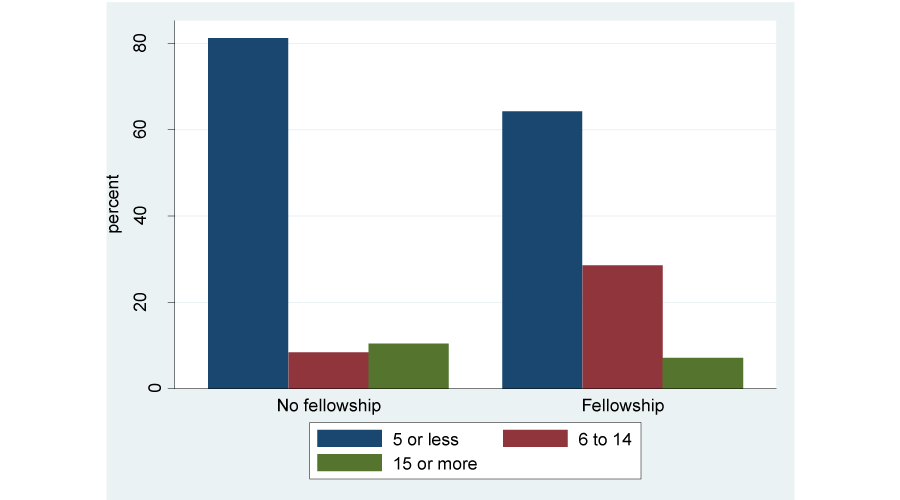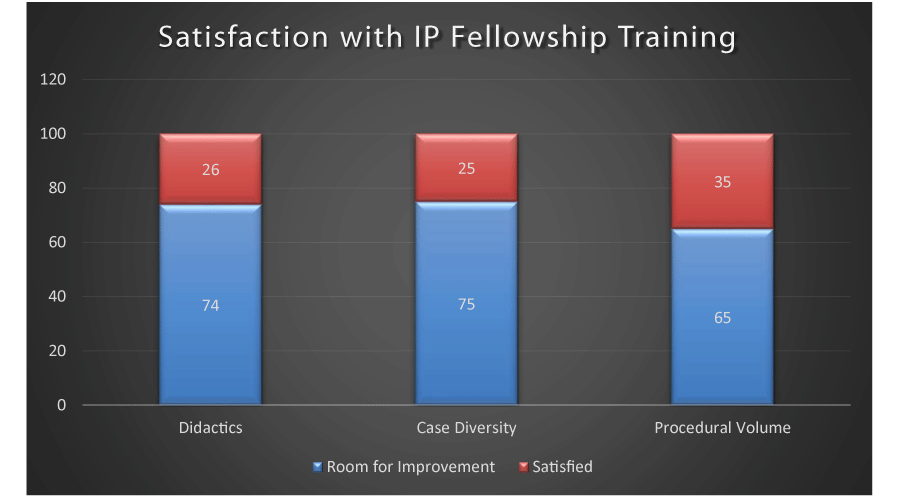Authors:
Abid Butt1*, Rodrigo Cavallazzi2 and Umair Gauhar2
1Department of Critical Care Medicine, King Faisal Specialist Hospital & Research Center, Riyadh, Kingdom of Saudi Arabia 2Division of Pulmonary, Critical Care, and Sleep Disorders Medicine, Department of Medicine, University of Louisville, KY, USA
Received: 25 May, 2016;Accepted: 02 July, 2016;Published: 04 July, 2016
Abid Butt, MD, FCCP, Department of Critical Care Medicine, King Faisal Specialist Hospital & Research Center Riyadh, Kingdom of Saudi Arabia, Tel: +966 11 442 4731; E-mail:
Butt A, Cavallazzi R, Gauhar U (2016) Interventional Pulmonology in 2015: A Survey of Practice Patterns and Future Directions of this Emerging Field. Arch Pulmonol Respir Care 2(1): 020-023.
© 2015 Butt A, et al. This is an open-access article distributed under the terms of the Creative Commons Attribution License, which permits unrestricted use, distribution, and reproduction in any medium, provided the original author and source are credited.
Interventional pulmonology; Survey; Practice patterns
Background: Interventional Pulmonology (IP) training through formal fellowship programs have become increasingly popular over the last several years. There is a dearth of data on the current practice of IP in the United States. The objective of this study was to identify the practice patterns of current IP practitioners.
Methods: We sent a survey to the members of the American Association of Bronchology and Interventional Pulmonology (AABIP) – the largest association of American IP practitioners. We analyzed the responses and stratified the responses to compare, when possible, how the practice patterns of the IP fellowship trained physicians varied from those who did not undergo formal fellowship training.
Results: We received a reply from 97 individuals. There was a noticeable difference in the practice patterns of respondents who had undergone fellowship training in IP versus those who had not, particularly with respect to volume and diversity of procedures performed. A small percentage of respondents appeared responsible for most of the advanced therapeutic procedures as well as ongoing research in the field of IP.
Conclusions: Our study is, to our knowledge, the first to capture the state of affairs of practicing Interventional Pulmonologists in the US. Our survey raises hopes as well as concerns about the benefits associated with an additional year of training in IP. We feel this survey will serve as an important aid for IP practitioners, fellowship directors, and IP fellows (both current and future) to further define clinical and research priorities and to foresee any future challenges in the field.
Introduction
Interventional pulmonology (IP) is a relatively new but rapidly expanding branch of Pulmonology. While some of the tools used by Interventional Pulmonologists are decades old (e.g. the flexible bronchoscope was introduced in 1968) [1], the field’s recent popularity appears to stem from the rapid proliferation of technically advanced diagnostic tools. Modern bronchoscopic equipment such as endobronchial ultrasound (EBUS) and electromagnetic navigational bronchoscopy (ENB) have revolutionized the management of many pulmonary diseases and have been thoroughly validated [2], in lung cancer staging and diagnosis of pulmonary parenchymal abnormalities. There has also been a resurgence of interest in advanced therapeutic bronchoscopy particularly rigid bronchoscopy. This interest has driven a dramatic increase in the number of training positions offering dedicated 12-month IP training in North America. As an illustration, there were 5 such programs [3], listed with the American Association of Bronchology and Interventional Pulmonology (AABIP) in 2007. By the 2015-2016 training year, this number had increased to 26, an increase of more than 500%. Despite the significantly increased number of training positions, it remains unclear whether this was in response to an unmet demand or whether these supra-specialized graduates were vfinding themselves in positions where they were unable to utilize all the skills they had acquired in the additional year(s) of training. The goal of our survey was to bridge this gap in our knowledge and gain an understanding of the current practice paradigm of IP practitioners in the United States.
Materials and Methods
Our study is a cross-sectional analysis of Interventional Pulmonology Practitioners using a web-based survey (www.surveymonkey.com). We did not obtain Institutional Board Review approval as there was no question pertained to private patient information. The survey was sent to members of the American Association of Bronchology and Interventional Pulmonology (AABIP) after soliciting feedback on the survey design and question content from the AABIP leadership. The AABIP was chosen as the forum for the survey as it is the largest organization of American practitioners of Interventional Pulmonology. Recipients of the survey were asked to fill out a questionnaire on their IP training (whether via a formal fellowship or self-directed), current practice, the scope and volume of procedures they currently performed, the use of sedation and anesthesia in their endoscopy suite, as well as satisfaction with their career choice. Question formats included multiple choice, matrix scale rating as well as single and multiple free text entries.
Statistical analysis
We performed descriptive analyses for all variables included in the study. Median and interquartile range are reported for continuous variables. Proportions are reported for categorical variables. Statistical inference was performed to compare participants with IP fellowship training from those without it. We used the Wilcoxon Rank-Sum (Mann-Whitney) test for comparing continuous variables, and the Fisher’s exact test for comparing categorical variables. We carried out all statistical analysis with Stata 10 (Stata Corp, College Station, Texas). As some respondents did not answer every question in the survey, the sample size for individual questions differed across the survey. Answers from one respondent were removed from the final analysis after it was noticed that the responses appeared contradictory or not relevant to the question being asked. When an individual answer was given in the form of a range, the median value was used for statistical analysis purposes. In the few instances where an answer was given as >x then x+1 was used for analysis purposes.
Results
The survey was answered by 97 individuals, of whom 26% (25 of 97) had dedicated fellowship training in IP (hereafter referred to as Formal IP Trainees (FIPT)) while the remainder (Non-IP Trainees or NIPT) acquired their skills during or after their Pulmonary and Critical Care Fellowship (PCCF).
Matching into IP fellowships
The FIPT reported that 90% (18 of 20) matched into an IP fellowship program within a year of applying, and that 85% (17 of 20) started their IP training immediately following their PCCF.
Obtaining privileges to perform IP procedures
For the FIPT, 42% (7 of 19) obtained privileges to perform the procedures they were trained in immediately, with 89% (17 of 19) getting them within 3 months of starting. The remaining two had to wait for 6 and 12 months to get full privileges. On the other hand, only 18% (8 of 45) of the NIPT obtained IP privileges immediately, with 66% (34 of 45) getting privileges within 3 months of starting. 24% (11 of 45) of the NIPT had to wait for more than 3 months, with the range being four to thirty-five months to obtain full IP privileges. IP skills training workshops proved popular among NIPT respondents, with 84% (56 of 67) reporting attending such training. Whether this was related to privileging needs was unclear.
Clinical practice of IP
The breakdown of clinical time and practice setup is listed in Table 1 and Figure 1 respectively. Note that there was no statistical difference in the practice setup of the two groups.
-

Figure 1:
Practice setup of IP Practitioners.
Procedural colume
We asked the respondents to quantify the number of advanced diagnostic, advanced therapeutic and pleural procedures they had done over the last six months. These are listed in Table 2 and illustrated in Figures 2,3. We were also curious to find out the variation in practice regarding sedation for various procedures. Table 3 lists only those procedures for which there was a statistical difference between the cohorts.
-

Table 2:
Procedural Volume.
-

Figure 2:
Procedural Volume.
-

Figure 3:
Number of Medical Thoracoscopies.
-

Table 3:
Procedural Sedation.
Research and publications
56% (9 of 16) of the FIPT and 78% (38 of 49) of the NIPT reported having less than 10% dedicated time for research, while 44% (7 of 16) of the FIPT vs 18% (9 of 49) of the NIPT had 11-30% dedicated time for research. 53% (8 of 15) of the FIPT reported receiving grant monies or other sources of funding dedicated for research, while 27% (14 of 51) of the NIPT had the same. While these differences were not statistically significant, they did have an impact on the number of publications reported by both groups (Table 4).
-

Table 4:
Support for research.
Satisfaction with career and training
We asked the respondents to quantify their satisfaction with IP as their career choice, and specifically queried the FIPT regarding their perceptions of the adequacy of their subspecialized training using a satisfaction score ranging from 1-10 (with 10 representing very satisfied) (Figure 4). We found that 70% (16 of 23) of the FIPT respondents chose 9 or 10 on the scale with 30% (7 of 23) choosing 7 or 8. For the NIPT, 52% (22 of 42) chose 9 or 10 on the scale, 31% (13 of 42) chose 7 or 8, while 12% (5 of 42) chose 5 or 6, and one respondent each chose 3 and 1 on the scale.
-

Figure 4:
Satisfaction with Fellowship training in IP.
Discussion
The field of ‘modern’ IP is relatively new and appears to be increasingly popular among trainees as evidenced by the burgeoning number of training positions. A fellowship in Interventional Pulmonology entails an additional 1-2 years of advanced training. During this time trainees are exposed to advanced procedures, both diagnostic and therapeutic, to which their exposure in traditional Pulmonary and Critical Care fellowship has traditionally been limited at best. There are however, several unanswered questions regarding the significance of this extensive undertaking, some of which we have tried to address. We believe our data provides the first comprehensive look at practice patterns among members of the Interventional Pulmonology community in North America.
We presumed that by looking at practice patterns of both fellowship trained and non-fellowship trained IP practitioners, we would get some insight into the demands of the US healthcare system, and that by categorizing the respondents into those who had formal IP fellowship training (FIPT) and those who did not (NIPT), we would be able to discern differences in the practice patterns of these two cohorts.
Our data suggested ongoing demand for FIPT physicians, as the time duration between finishing fellowship and starting at an IP position was less than six months for all respondents. Despite no real difference in time allocated for research, they were publishing more manuscripts than their non-IP trained peers. This difference may be a function of the varying nature of employment model with resultant pressures and markers of performance between the two cohorts because the FIPT were more likely (though not significantly so) to be in academics than the NIPT.
As there are only a limited number of academic positions available in the country, it remains unclear whether there is enough of a market outside the tertiary care, academic medical centers for these highly skilled physicians. If there isn’t, this may result in future graduates being shunted into the private practice employment model, where the time spent to reimbursement ratio can be a determinant in how patient care is driven [5]. We suspect that in this model, FIPT physicians would have limited time and opportunity for practicing their therapeutic skills outside of some limited airway debulking. This contention should give pause to the current ever-increasing number of training positions offered in IP. Already, most FIPT graduates felt they had gaps in their training, and if these gaps were compounded by low volumes experiences once they were out in practice, this would lead to questions of ongoing competency. Our data does not support this contention, except indirectly in that NIPT physicians in private practice appeared to be performing less advanced therapeutic procedures. This would form an interesting idea for a future study.
There are of course several limitations to our study. As with any survey, our analysis is limited to those who responded to the survey, and we were unable to ascertain the total number of people the survey was sent to. In addition, there are IP practitioners not on the AABIP mailing list. As such, we cannot claim that our data is fully representative of every single practitioner. Some of the answers could not reach statistical significance because of the small sample size.
We feel this report identifies important trends in the IP community, both promising and worrisome. Overall, career satisfaction amongst IP practitioners remains high but whether this will be sustained given the challenges mentioned above, in conjunction with the uncertainty of and ongoing evolution in the American healthcare delivery system is difficult to predict.
-
-
- Ikeda S, Yanai N, Ishikawa S (1968) Flexible Bronchofiberscope. Keio J Med 17: 1-16 .
- Gould MK, Fletcher J, Iannettoni MD, Lynch WR, Midthun DE, et al. (2007) Evaluation of patients with pulmonary nodules: when is it lung cancer?: ACCP evidence-based clinical practice guidelines (2nd edition). Chest 132: 108S–130S .
- Yarmus L, Feller-Kopman D, Imad M, Kim S, Lee HJ (2013) Procedural volume and structure of interventional pulmonary fellowships Chest 144: 935-939 .
- Bowling MR1, Kohan MW, Walker P, Efird J, Ben Or S (2015) The effect of general anesthesia versus intravenous sedation on diagnostic yield and success in electromagnetic navigation bronchoscopy. J Bronchology Interv Pulmonol 22: 5-13.
- Greenhil SR, French KD, Roberts H, Vance M, Diamond EJ, et al. (2009) Time and cost commitments of Pulmonary Procedures: Impact on overall practice and access to care. Chest 136: 84S .
-











Table 1:
Utilization of total clinical time.
(n = 53)